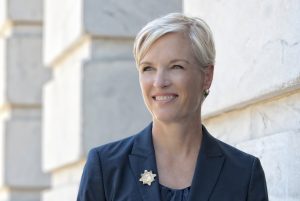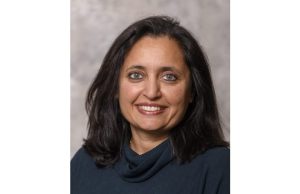The recent merger between public broadcasting stations WNET/Ch.13 and WLIW/Ch.21 in New York was pushed not by a lack of fundraising acumen but because of a technology crunch being felt across the nation. Stations must comply with the Federal Communications Commission (FCC) to change to digital broadcasting by May, 2003.
“The costs are extraordinary,” said Paula Kerger, vice president and station manager for WNET/Ch.13. “The merger is symbolic of the needs of PBS around the country as they grapple with costs required to fund the transition.”
It’s also being complicated because WNET/Ch.13 lost two analog transmitters, a digital transmitter with its antennae and a key engineer during the loss of the World Trade Center.
“We went from being a broadcaster to being a non-broadcaster,” said Kerger. “Now we are in a rebuilding mode so that we’re not even focused on the digital part of the equation. Right now we’re still not on the air with a full power broadcast for the analog signal.”
One-third of WNET’s audience sees the signal over the air so it lost one third of its audience. The short term solution is using an antenna in Alpine, N.J. However this is a lower power due to the shorter antennae.
The permanent solution ranges from using the Empire State Building to constructing another tower. Presently the station is working with commercial broadcasters of the city to come up with a solution for the analog problem.
Kerger explained that the setback will not affect its merger with WLIW. “Our merger agreement was signed around the time of the disaster and is now going to the FCC so it’s moving forward,” Kerger said. “Besides looking at our facility issues, we’re looking at those of LIW to grapple with its need to convert to digital.”
Combining activities
The stations currently are broadcasting an analog signal but those must be converted to a digital format in the same zeros and ones of the computer world. All broadcast equipment, from antennas and transmitters to cameras and editing equipment, totals almost $1.35 billion nationally, according to the Association of America’s Public Television Stations (APTS) in Washington, D.C. So far, only $600 million has been raised at the state and local level.
There are 354 Public Broadcasting Service (PBS) stations which are controlled by 175 licensees. A number of state networks exist, such as those in Kentucky, South Carolina and Maryland.
“Many stations operate quite lean and being hit by a large capital expense is a driving force that could bring them together,” Kerger said. “The goal is to see what can be shared or reduced by eliminating a service that is simply duplicated.”
WNET’s costs are roughly $30 million while WLIW faces costs estimated at $10 million. WNET deals with greater needs because of its national production content.
With the merger, the Educational Broadcasting Corporation, as the parent corporation of WNET, becomes the licensee for both stations. The WLIW board remains separate but gains eight seats on the WNET board. The WLIW president now reports to the WNET president.
One obvious benefit to WLIW is the access to WNET’s new digital production facilities. “WLIW has an enormous need to have a voice for the Long Island community,” Kerger said. “Rather than struggle to build transmitters and antennas, they wanted to look for ways to pump resources into programming.”
Talk of the merger possibility began with production facilities, such as the master control. The parties soon realized they had an opportunity to operate more efficiently by coming together. In the conversion process, stations must maintain the analog broadcasting. “Besides the technical requirement, we have to maintain our analog broadcasting until enough people are using the digital signal,” she said. “Then, we’ll shut down the analog but we’ll have higher operating costs, including power bills until then.”
The merger helps both stations because a cross promotion between two channels helps programming. Also, programming not focused on either specific community can be coordinated in one place. “We could gain economies of scale in areas like handling membership and database management,” she said.
However, Kerger explained the details have not yet been set up. In general, fundraising will be done separately, as the stations want to have separate voices. “Certainly in major gifts there is a reason to have separate areas. We want people experienced with the specific community to continue where they work.”
Some stations will partially deal with transition. The station might fund a transmitter and antenna to become a path for service from PBS nationwide programs. The station can accomplish that for around $2 million.
“But if they want to do local content, then the costs will be greater and providing this service is the real mission of a PBS station,” Kerger said.
The crisis over funding is highlighted by the contrast between WILW’s costs estimated at $10 million while its operating budget is just $11 million.
WNET’s merger shows one model for stations to work together to use resources. At the other end of the spectrum, a station can enter an operating agreement to sharing the master control with a facility that has digital.
The classic example from the commercial world is how the FOX network provides all station operations including inserts of local traffic advertising from a single facility in Los Angeles. Such central casting could help key PBS stations today.
Right now much of the technical guidance and research is being handled by the Public Broadcasting Service (PBS) in Alexandria, Va. PBS is a private, nonprofit media enterprise owned and operated by the nation’s public television stations. PBS serves nearly 100 million people each week. The organization’s production of nationwide content provides the National Program Service, the PBS Kids series, which is related to children’s programs and a service called PBS You that serves as a lifelong learning service.
“A station that doesn’t have local production for digital could use these programs,” said Wayne Godwin, executive vice president, member affairs. However dependence on the PBS packages should be a temporary bandage. “We want stations to produce their own digital services in their communities,” he said. “But we understand in this transition they will not be at the same point of ability to produce, so this becomes a skeleton base upon which to build.”
The transition is chaotic, an opportunity and a time of consolidation all at the same time, according to John Lawson, president and CEO, Association of America’s Public Television Stations in Alexandria, Va. The association is a membership organization made up of public television licensees and provides advocacy before Congress and regulatory agencies.
“The conversion creates a rare second chance to have a greater impact on the society,” he said. “Right now our stations have to make a draconian choice in a one channel environment but with digital we will be able to reach more audiences at the same time.”
Lawson explained that New York’s example of dealing with conversion is an exception. “They have carefully cultivated community support,” he said. “But only around half the stations are raising funds at the local and state level.”
Currently, 34 stations have made the conversion and reach approximately 50 percent of the country’s television viewers. Some stations are assessing the needs, while others are planning to raise funds. “We don’t know the ability of many rural communities to support these stations, especially with the economic downturn,” he said. “A possible dwindling of the number of licensees could occur as a consolidation hits.”
In some markets, the crisis could see links between commercial stations and PBS, according to Jon Abbott, vice president and general manager for the television station at WGBH Educational Foundation in Boston. WGBH maintains channels 44, 57 and 2.
“The coordination doesn’t have to be a merger,” he said. “In New York, the environment for the merger started with the notion of avoiding multiple originations, but other options besides merger exist.”
The long term picture for Abbott could include central casting with a group of New England stations where one handles the master control and broadcast origination. “We just began the conversions with some others,” he said. “This might be a chance to build a hub in New England for other PBS stations just because of the closeness.”
WGBH’s station in Springfield, Mass. has converted and one other hopes to be online by September. The licensee produces much of the programming for the PBS schedule. “We have two analogs and have spent two years trying to see how to create two services from one infrastructure so we’re being smarter about the management,” he said.
How are stations handling the funding? WGBH has a budget of approximately $30 million and has just raised $43 million during a capital campaign. One component sought funds for digital transition. “The challenge for us was to raise the funds for the transition as well as funds for the usual program development,” Abbott said.
The immediate needs are for $7 million slated for the studios and the transmission facilities with the full cost of $15 to 20 million spread over time. “A more prolonged transition exists in the internal operations,” Abbott said. “We have been funding in part through funded depreciation and also additional campaign fundraising over a seven to eight year project.”
WGBH uses a spend down concept where it amasses a pool of nonprofit investment venture capital. The station then taps those funds over a few years to launch needed new concepts. “Most times we will spend down the funds to zero and replenish with the next campaign,” he said. “It provides us with timely early money when we need it until corporate funders and individual funders came along.”
Staffing needs would become a problem if the station tried to duplicate a staff for the digital channels as well as the analog. WGBH is building a team to handle multiple channels.
In New York, WNET ran a capital campaign to raise funds for conversion and also tapped a $70 million endowment for the station. “Few PBS stations have endowments,” Kerger said. “We put into place a planned giving program 10 years ago and we focused on building the endowment to cover the increasing costs.”
WNET spent $30 million on new offices to upgrade from an old hotel with poor wiring. “When we purchased the new building we knew we had to sustain computer terminals to carry the extra power,” she said. “Now we have more square footage with a compact technical plant, a small studio and an editing room.”
WNET also rebuilt its master control to handle the flow from other stations. “We can now control the WLIW coordination and this means that they won’t have to spend those dollars,” she said. “As a former head of development, the campaign for digital is a hard sell because people really don’t understand what it means to complete such a change over.”
Kerger explained that some stations in upstate New York are looking at similar partnership ventures to either share production capacity, master control or membership operations. “Back office functions present many opportunities to share,” she said.
Unfortunately rural stations face the steepest climb. High capital costs don’t correlate with market size, especially as rural communities cover a wider geography.
A substantial number of stations will not make the deadline, according to Lawson. “They tend to be the ones that serve rural areas or other disadvantaged populations,” he said.
At least 17 states fail to have a television station in the top 50 markets. Some state networks might have headquarters in a city, but the transmitters go across many areas. The state might obtain federal funding but that could mean only one or two transmitters go on the air. “This means rural populations will not get digital soon,” Lawson said.
The FCC deadline might get pushed back, according to Lawson. However, the reality is that there will be extraordinary costs forcing stations to think about working together.
The New York merger could set an example for others around the country, explained Kerger. “In a market like this one, you might think there are resources, yet the aspect of sharing can make dollars go further.”
Tom Pope is a New York City-based journalist who writes about management issues.












